1. Ambrosia Salad
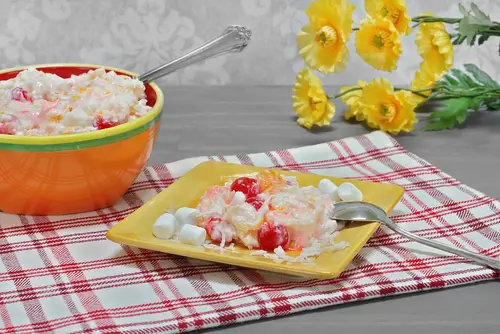
This neon-colored mix of canned fruit cocktail, mini marshmallows, and Cool Whip has been showing up on holiday tables for decades. The recipe traces back to the late 19th century, when fresh fruit was a luxury, but it took off in the mid-20th century with the rise of convenience foods. Today, most people don’t even like it, but Grandma insists it’s “refreshing.” Families keep making it because it feels like a tradition, even if no one eats more than a spoonful.
The problem is the texture—it’s both mushy and gummy, with an overpowering sweetness. Pineapple chunks clash with the cloying marshmallows, and the whipped topping tends to melt into a soupy mess. Kids often poke at it before politely passing it along. Still, it shows up every Easter or Christmas because it’s what “we’ve always done.”
2. Green Bean Casserole
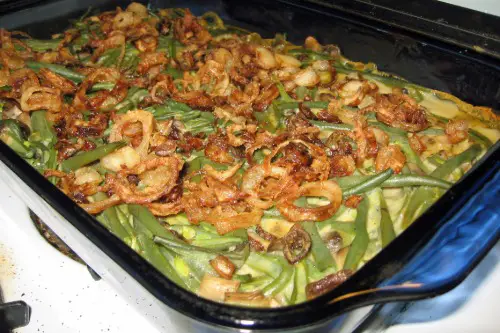
Campbell’s Cream of Mushroom Soup and crispy fried onions made this casserole a 1950s sensation. It was created by a Campbell’s test kitchen employee and quickly became a Thanksgiving standard. The reason it stuck is simple: it’s cheap, fast, and fits right in with turkey and stuffing. But most people secretly admit they’d rather have green beans sautéed in butter and garlic.
The dish is heavy, salty, and weirdly gloopy. The fried onions on top are the only part anyone actually looks forward to. Yet year after year, the casserole pan gets assembled, baked, and plopped on the buffet. It’s a classic example of a “dish we make for tradition, not taste.”
3. Jell-O Salad
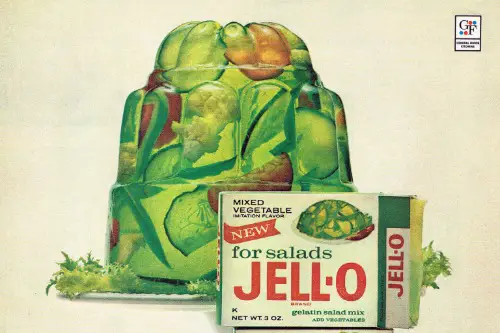
This one comes in endless variations—lime Jell-O with cottage cheese, strawberry with pretzels, orange with shredded carrots. The idea of combining gelatin with vegetables or dairy was a quirky mid-20th century fad. Somehow, entire cookbooks were devoted to these wobbly creations, and they’ve clung to church potlucks and family picnics ever since. They’re less dessert than questionable science experiments.
The biggest issue is the combination of flavors and textures that simply don’t belong together. Cottage cheese suspended in gelatin is hard to stomach, and lettuce encased in orange Jell-O is even worse. Still, some families make them to honor the memory of a beloved aunt or grandma. Nostalgia wins, even when taste buds lose.
4. Tuna Noodle Casserole
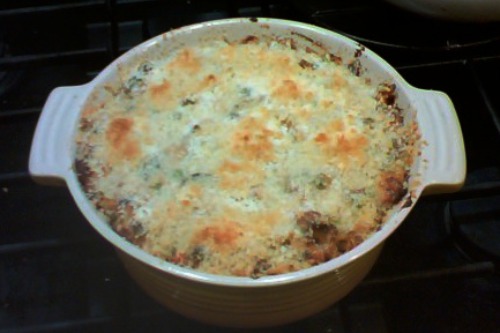
This was born in the 1950s as a budget-friendly way to stretch a can of tuna. With cream of mushroom soup, egg noodles, and a sprinkling of breadcrumbs, it became a weeknight staple. Many kids who grew up eating it remember it with a mix of fondness and dread. It’s hearty, but also notoriously bland and fishy.
The noodles soak up the grayish sauce until it all becomes one heavy lump. The tuna flavor overpowers everything, and reheating it the next day makes the smell even worse. Still, families keep the recipe alive as a symbol of practicality and frugality. It’s less about taste and more about remembering how mom “made dinner stretch.”
5. Aspic
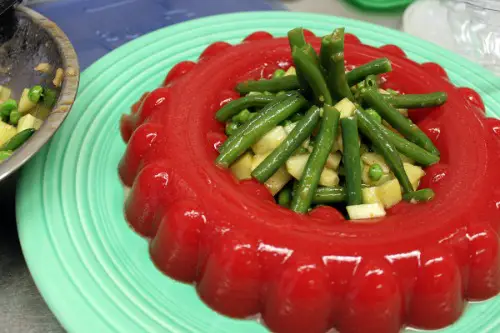
Once considered glamorous, aspic is basically meat stock turned into gelatin and molded with vegetables or even meats inside. In the mid-20th century, fancy cookbooks touted it as sophisticated centerpiece fare. Today, the sight of peas and ham floating in a jiggling dome just feels unsettling. But some families still bring it out as a quirky relic of the past.
The taste is savory Jell-O, which is not something most modern palates appreciate. The texture is slimy and rubbery, making it difficult to chew. Many people take one polite bite and leave the rest behind. Yet it shows up at retro-themed family gatherings, often introduced with a laugh about “keeping the tradition alive.”
6. Creamed Chipped Beef on Toast

Also known as “SOS” (short for “stuff on a shingle”), this dish has deep military roots. It was a staple for U.S. soldiers in the early 20th century, made from dried beef and white gravy poured over toast. After World War II, many veterans brought the recipe home, passing it down as a quick breakfast or dinner. The taste, however, leaves much to be desired.
The gravy is gluey, salty, and sticks to your mouth. The beef itself is often leathery and overly briny. Kids tend to push it around the plate, hoping not to offend whoever made it. Still, some families keep making it as a nostalgic nod to dad or grandpa’s service.
7. Liver and Onions
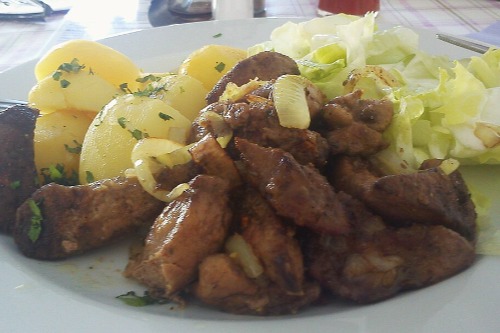
For much of the 20th century, liver was touted as a powerhouse of nutrition. Families served it fried with onions to mask the metallic taste. Parents insisted on it because it was cheap protein and full of iron. But for kids and even most adults, the flavor was unbearable.
The strong mineral taste and chewy texture made it one of the most dreaded dinners. Many remember being forced to sit at the table until they cleaned their plate. Even though modern diets don’t require it, some families still trot it out occasionally “for health.” It’s one of those meals remembered more for the fight than the flavor.
8. Fruitcake
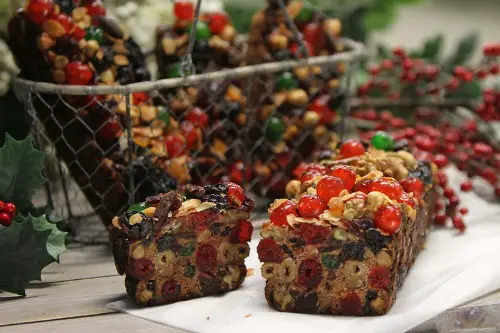
Dense, heavy, and packed with neon-colored candied fruit, fruitcake has been the butt of jokes for decades. Its origins go back centuries, but in the U.S. it became a standard Christmas gift. Most people admit they don’t actually eat it—they just regift it or leave it on the counter until New Year’s. Still, it keeps coming back every December.
The cake itself is dry, overly spiced, and weighed down by sticky, artificial fruit. Some recipes even call for soaking it in alcohol, which only helps slightly. Families often bake one because it’s “tradition,” not because anyone’s excited. It’s less a dessert and more a seasonal obligation.
9. Bologna Cake
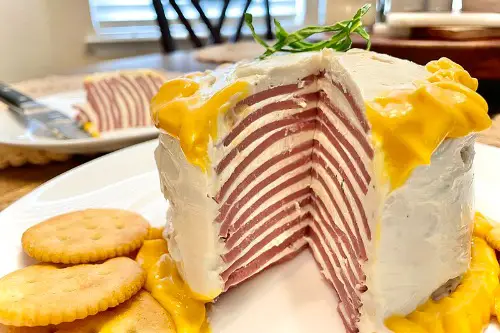
This is exactly what it sounds like: layers of bologna “frosted” with cream cheese, then sliced like a cake. It became popular in the 1970s as a kitschy appetizer for parties. Families who grew up with it still make it for laughs or out of nostalgia. But once the novelty wears off, you’re still eating cold bologna and cream cheese.
The taste is overwhelmingly salty and greasy, with a strange texture that doesn’t feel celebratory at all. Sliced into wedges, it looks like something from a prank cookbook. Yet some families won’t let go of the recipe, partly for shock value. It’s the kind of dish everyone remembers, but not fondly.
10. Macaroni Salad with Miracle Whip
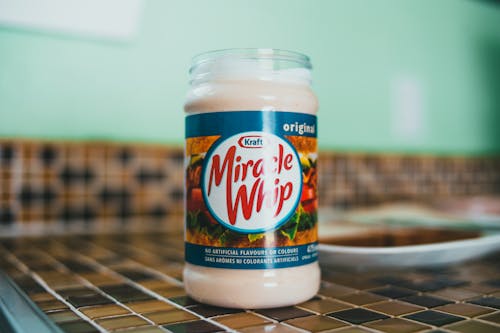
At every summer cookout, this dish shows up: elbow macaroni, chopped veggies, and a mayo substitute. Miracle Whip was heavily marketed as a lighter, tangier alternative to mayonnaise starting in the 1930s. Families adopted it as the “correct” binder for cold pasta salads. The problem is that most people don’t actually enjoy the overly sweet flavor.
The texture is often mushy, with limp pasta and watery vegetables. The tangy dressing overwhelms everything else, leaving a cloying aftertaste. Still, many families refuse to swap Miracle Whip for mayo, saying it “wouldn’t taste right.” Tradition wins over good sense.
11. Sloppy Joes
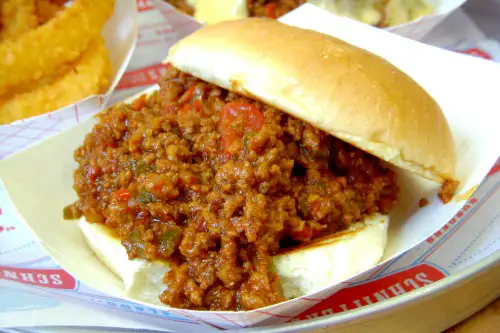
Loose ground beef in a ketchup-heavy sauce on a bun—Sloppy Joes are a weeknight staple from the 20th century. They were marketed as an easy, kid-friendly dinner, with canned mixes like Manwich making them even simpler. But the truth is, most people remember them as messy, greasy, and strangely sweet. They’re more nostalgia than culinary delight.
The sauce often soaks through the bun, leaving you with a soggy mess in your hands. The meat is bland, tasting mostly of ketchup and sugar. Still, they pop up at family reunions and camping trips because “everyone knows how to make them.” They’re less about flavor and more about shared childhood memories.
12. Congealed Salad with Mayonnaise

Think of Jell-O salad but worse—this version suspends mayonnaise, celery, and sometimes even olives inside gelatin. It was especially popular in the 1950s, when gelatin molds were considered a mark of domestic creativity. Families keep the recipes tucked in church cookbooks and pull them out for retro potlucks. Most modern eaters recoil at the very idea.
The sweetness of Jell-O clashing with tangy mayo is a culinary crime. The rubbery texture makes it nearly impossible to enjoy. People smile politely and take a slice, but most of it ends up in the trash. Still, some families insist it’s “just not a holiday without it.”
13. Cabbage Soup Diet Soup
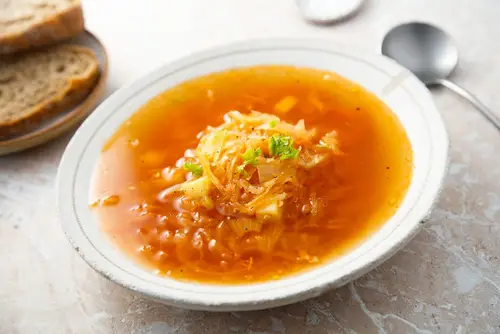
This infamous recipe became a fad in the 1980s and 1990s as part of a crash diet. Families often made giant pots of it, not because it was delicious, but because it promised quick weight loss. The base was simple: cabbage, onions, tomatoes, and broth, simmered until everything turned limp. It was more punishment than pleasure.
The soup is watery, sulfurous, and monotonous after one bowl. Families who tried the diet often passed the recipe around, claiming it was “healthy” even though no one liked it. Some still cook it as a “cleanse” or quick way to stretch a dollar. But its legacy is mostly grim faces over steaming bowls.
14. Meatloaf with Ketchup Glaze
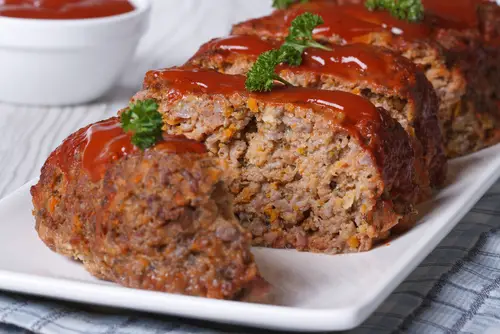
Meatloaf itself isn’t inherently bad, but the ketchup-glazed version became infamous in many American households. The idea was to stretch ground beef with breadcrumbs and eggs, then smother it with ketchup. It was practical during the Depression and wartime rationing, and families kept making it because it was filling. But the end result is usually dense, dry, and overwhelmingly tomato-flavored.
Slices tend to crumble apart, and the sugary glaze burns more often than it caramelizes. Many kids dreaded “meatloaf night,” remembering it as tough and flavorless. Still, families cling to their recipes as weeknight staples. Even if everyone prefers burgers, meatloaf keeps showing up.
15. Hot Dog Casserole

This dish often combines chopped hot dogs with canned beans, instant potatoes, or even biscuits on top. It was designed as a thrifty, kid-friendly meal, and many families leaned on it during tight times. But while kids might have tolerated it, adults usually knew it was far from gourmet. Still, it appears in family recipe boxes and potluck spreads.
The flavors are oddly mismatched, with salty hot dogs clashing against mushy beans or canned soup. The texture is either watery or gluey, depending on how it’s cooked. Most people don’t crave it as adults, yet they keep making it to honor family history. It’s comfort food in theory, but rarely in practice.
This post 15 Recipes Families Still Pass Down Even Though Everyone Knows They’re Terrible was first published on American Charm.


